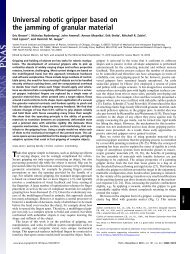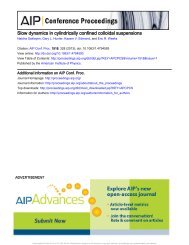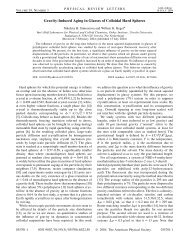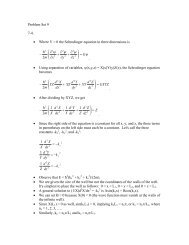Distribution of Glass Transition Temperatures in Free-Standing ...
Distribution of Glass Transition Temperatures in Free-Standing ...
Distribution of Glass Transition Temperatures in Free-Standing ...
Create successful ePaper yourself
Turn your PDF publications into a flip-book with our unique Google optimized e-Paper software.
Macromolecules<br />
<strong>in</strong>volv<strong>in</strong>g neutron reflectivity measurements 17 on multilayer<br />
films <strong>of</strong> hydrogenated and deuterated PS and dielectric spectroscopy<br />
studies <strong>of</strong> multilayer films with one layer conta<strong>in</strong><strong>in</strong>g<br />
polymer labeled at low levels with a high dipole moment dye. 18<br />
In a related molecular dynamics simulation study, Peter et al. 19<br />
found that average cooperative dynamics <strong>in</strong> a film are accelerated<br />
due to a smooth gradient <strong>in</strong> relaxation orig<strong>in</strong>at<strong>in</strong>g from the free<br />
surface, where segmental relaxation occurs much faster than <strong>in</strong><br />
the bulk. Further experimental support for enhanced mobility at<br />
the surface <strong>of</strong> polymer films comes from a variety <strong>of</strong> sources. For<br />
example, Fakhraai and Forrest 20 produced well-def<strong>in</strong>ed nanodeformations<br />
on the surface <strong>of</strong> supported PS films. They observed<br />
surface relaxation over a 277 369 K temperature range, far<br />
below T g,bulk and consistent with enhanced free-surface mobility.<br />
Tsui and co-workers 21 studied the viscosity <strong>of</strong> unentangled,<br />
short-cha<strong>in</strong> supported PS films, obta<strong>in</strong><strong>in</strong>g a Kauzmann temperature,<br />
T K , as a function <strong>of</strong> thickness by application <strong>of</strong> a Vogel<br />
Fulcher Tamman equation to the experimentally determ<strong>in</strong>ed<br />
temperature-dependent viscosity. They found a reduction <strong>in</strong> T K<br />
with decreas<strong>in</strong>g thickness below 20 nm. From hydrodynamic<br />
analysis and application <strong>of</strong> a two-layer model, they <strong>in</strong>terpreted<br />
that a highly mobile surface liquid layer was present with a<br />
thickness <strong>of</strong> less than 2.3 nm and <strong>in</strong>dicated that this mobile<br />
surface layer is responsible for the effects <strong>of</strong> conf<strong>in</strong>ement on the<br />
effective viscosity and the T g <strong>of</strong> PS films.<br />
In contrast to the many dozens <strong>of</strong> <strong>in</strong>vestigations <strong>of</strong> the<br />
T g -conf<strong>in</strong>ement effect and related behavior <strong>of</strong> polymer films<br />
supported on silica, fewer studies have focused on the T g -conf<strong>in</strong>ement<br />
effect and related properties <strong>of</strong> s<strong>in</strong>gle-layer free-stand<strong>in</strong>g<br />
films, 22 47 i.e., films with two polymer air <strong>in</strong>terfaces or free<br />
surfaces. Us<strong>in</strong>g Brillou<strong>in</strong> scatter<strong>in</strong>g and ellipsometry, Dutcher<br />
and co-workers 22 27 were the first group to characterize the<br />
T g -conf<strong>in</strong>ement effect <strong>in</strong> free-stand<strong>in</strong>g polymer films, do<strong>in</strong>g<br />
studies on PS and PMMA. The most strik<strong>in</strong>g features associated<br />
with their free-stand<strong>in</strong>g PS film studies are that the T g reductions<br />
can be much greater than those <strong>of</strong> PS films supported on silica<br />
(T g reductions as large as 70 80 K were reported <strong>in</strong> free-stand<strong>in</strong>g<br />
22<br />
films relative to bulk T 25 g ) and that at high MW there is a<br />
strong MW dependence <strong>of</strong> the T g reduction.<br />
Unlike free-stand<strong>in</strong>g PS films, <strong>in</strong> supported PS films there is no<br />
significant MW dependence <strong>of</strong> the T g -conf<strong>in</strong>ement effect. 48 This<br />
difference between free-stand<strong>in</strong>g and supported PS films is one <strong>of</strong><br />
the most <strong>in</strong>trigu<strong>in</strong>g results to arise from studies <strong>of</strong> the effects <strong>of</strong><br />
nanoscale conf<strong>in</strong>ement on glass-formers. de Gennes 29 proposed<br />
a simple physical picture <strong>of</strong> “slid<strong>in</strong>g motion” to expla<strong>in</strong> the cha<strong>in</strong>length<br />
dependence <strong>of</strong> T g <strong>in</strong> nanoconf<strong>in</strong>ed, free-stand<strong>in</strong>g films.<br />
He suggested that the mobility <strong>of</strong> a polymer cha<strong>in</strong> can be greatly<br />
enhanced if loops or bridges from the cha<strong>in</strong> extend to the surface<br />
region <strong>of</strong> the th<strong>in</strong> film. In de Gennes’ mechanism, the loops <strong>of</strong> a<br />
cha<strong>in</strong> present at a free surface can transport “k<strong>in</strong>ks” <strong>of</strong> free<br />
volume along the cha<strong>in</strong>’s own length, allow<strong>in</strong>g for faster structural<br />
relaxation and thereby <strong>in</strong>duc<strong>in</strong>g a reduction <strong>in</strong> local T g . The<br />
model leads to a function T g (z) which depends on the distance z<br />
from a free surface. As a result <strong>of</strong> the slid<strong>in</strong>g motion, T g is<br />
expected to decrease <strong>in</strong> regions near the free surface at distances<br />
comparable to the size <strong>of</strong> a polymer coil (i.e., the diameter <strong>of</strong> the<br />
volume pervaded by a cha<strong>in</strong>) because additional free volume can<br />
presumably be transported from the loops at the free surface over<br />
a thickness related to coil diameter. Conversely, with de Gennes’<br />
mechanism, bulk T g is expected <strong>in</strong> <strong>in</strong>terior regions <strong>of</strong> the film<br />
where no polymer cha<strong>in</strong> is present that has segments form<strong>in</strong>g<br />
loops at the free surface. This mechanism provides a potential<br />
ARTICLE<br />
explanation for the important role <strong>of</strong> MW on the T g -conf<strong>in</strong>ement<br />
effect <strong>in</strong> PS free-stand<strong>in</strong>g films and suggests a (semi)quantitative<br />
approach, based on the MW dependence <strong>of</strong> the polymer coil<br />
radius, to expla<strong>in</strong> this behavior.<br />
Here we employ a recently developed multilayer/self-referenc<strong>in</strong>g<br />
fluorescence method that yields T g values with<strong>in</strong> surface and<br />
<strong>in</strong>terior layers <strong>of</strong> known thickness. First reported <strong>in</strong> 2008, the<br />
self-referenc<strong>in</strong>g fluorescence method was developed to measure<br />
the T g -conf<strong>in</strong>ement effect <strong>in</strong> s<strong>in</strong>gle-layer free-stand<strong>in</strong>g PS films<br />
via the temperature dependence <strong>of</strong> a fluorescence <strong>in</strong>tensity ratio<br />
associated with a pyrenyl dye labeled to the polymer. 47 In most<br />
previous fluorescence studies <strong>of</strong> T g -conf<strong>in</strong>ement effects, fluorescence<br />
<strong>in</strong>tensity (at a specific wavelength or <strong>in</strong>tegrated over the<br />
whole spectrum) was measured as a function <strong>of</strong> temperature,<br />
with T g be<strong>in</strong>g obta<strong>in</strong>ed from the <strong>in</strong>tersection <strong>of</strong> the temperature<br />
dependences <strong>of</strong> the rubbery-state and glassy-state fluorescence<br />
<strong>in</strong>tensities. 6,10 16,48,49 However, such measurements do not<br />
yield accurate and precise T g determ<strong>in</strong>ations <strong>in</strong> free-stand<strong>in</strong>g<br />
films due to film rippl<strong>in</strong>g upon cool<strong>in</strong>g, result<strong>in</strong>g <strong>in</strong> changes <strong>in</strong> the<br />
surface area <strong>of</strong> the film exposed to fluorescence excitation light.<br />
Many pyrene-based dyes can exhibit strong sensitivity <strong>of</strong> fluorescence<br />
spectral shape to nanoscale environment, 50 54 and we<br />
discovered that the spectral shape <strong>of</strong> a pyrene dye covalently<br />
attached <strong>in</strong> a particular way to PS changes as a function <strong>of</strong><br />
temperature. 47 In turn, the use <strong>of</strong> an <strong>in</strong>tensity ratio to characterize<br />
the changes <strong>in</strong> spectral shape provides an accurate and precise<br />
self-referenc<strong>in</strong>g determ<strong>in</strong>ation <strong>of</strong> T g , <strong>in</strong>dependent <strong>of</strong> any change<br />
<strong>in</strong> the surface area <strong>of</strong> the film exposed to fluorescence excitation<br />
caused by film rippl<strong>in</strong>g. 47 In our 2008 study, data obta<strong>in</strong>ed by<br />
self-referenc<strong>in</strong>g fluorescence for average T g s across s<strong>in</strong>gle-layer<br />
free-stand<strong>in</strong>g PS films 47 were <strong>in</strong> reasonable agreement with<br />
results <strong>of</strong> Dutcher and co-workers; 22 25 a major reduction <strong>in</strong><br />
T g was evident with decreas<strong>in</strong>g thickness <strong>in</strong> films th<strong>in</strong>ner than<br />
80 90 nm, and the limited data set agreed with the MW<br />
dependence <strong>of</strong> the T g -conf<strong>in</strong>ement effect reported by Dutcher<br />
and co-workers.<br />
In particular, we have designed our current multilayer/fluorescence<br />
study to provide the first critical experimental test <strong>of</strong> de<br />
Gennes’ slid<strong>in</strong>g motion model <strong>in</strong> free-stand<strong>in</strong>g PS films. 29 By<br />
prepar<strong>in</strong>g trilayer films <strong>in</strong> which the middle layer conta<strong>in</strong>s<br />
pyrene-labeled PS and the two surface layers conta<strong>in</strong> neat PS<br />
without pyrene dye, we demonstrate for the first time that a<br />
major reduction <strong>in</strong> T g can be observed <strong>in</strong> the middle layer <strong>of</strong><br />
nanoconf<strong>in</strong>ed free-stand<strong>in</strong>g polymer films even when the cha<strong>in</strong>s<br />
with<strong>in</strong> that layer are unable to form loops at either <strong>of</strong> the two free<br />
surfaces. This contradicts a key premise <strong>of</strong> de Gennes’ model. We<br />
further compare our results for the distribution <strong>of</strong> T g s with<strong>in</strong> freestand<strong>in</strong>g<br />
nanoconf<strong>in</strong>ed PS films to those reported by Ellison and<br />
Torkelson 10 for supported nanoconf<strong>in</strong>ed PS films, demonstrat<strong>in</strong>g<br />
substantial agreement between the distributions <strong>of</strong> local T g <strong>in</strong><br />
these systems.<br />
’ EXPERIMENTAL SECTION<br />
1-Pyrenylmethyl methacrylate-labeled PS (MApyrene-labeled PS; 47<br />
M n = 805 000 g mol<br />
1 , M w /M n = 1.31, by gel permeation chromatography<br />
(GPC) relative to PS standards us<strong>in</strong>g tetrahydr<strong>of</strong>uran (THF) as<br />
eluent) was synthesized by bulk free radical polymerization <strong>of</strong> styrene<br />
(Aldrich) <strong>in</strong> the presence <strong>of</strong> trace amounts <strong>of</strong> 1-pyrenylmethyl methacrylate<br />
(MApyrene; Polysciences). The MApyrene-labeled PS was<br />
precipitated <strong>in</strong>to excess methanol and washed by redissolv<strong>in</strong>g <strong>in</strong> THF<br />
and precipitat<strong>in</strong>g <strong>in</strong> methanol seven times to remove any residual<br />
4547 dx.doi.org/10.1021/ma200617j |Macromolecules 2011, 44, 4546–4553



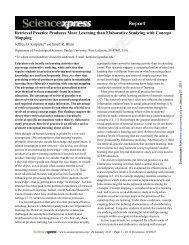
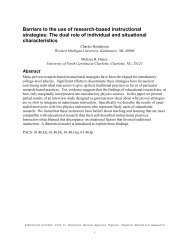
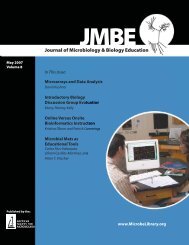

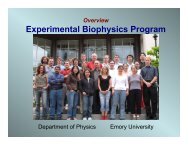


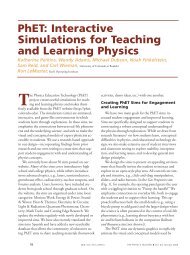
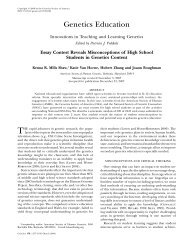
![view the Dish Show [PDF] - Department of Physics - Emory University](https://img.yumpu.com/45032745/1/190x146/view-the-dish-show-pdf-department-of-physics-emory-university.jpg?quality=85)

